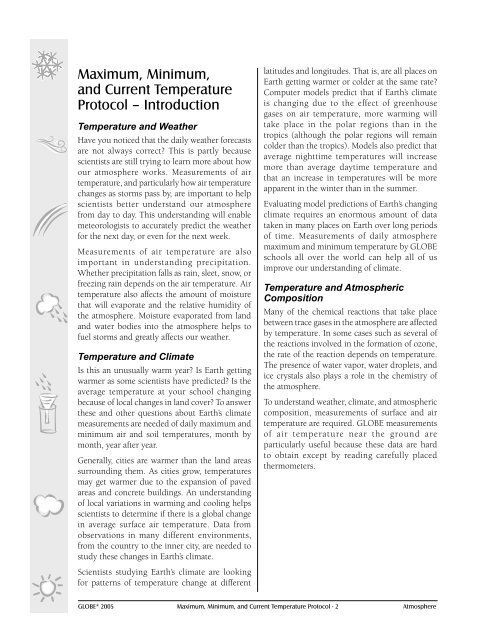Maximum, Minimum, and Current Temperature Protocol - GLOBE
Maximum, Minimum, and Current Temperature Protocol - GLOBE
Maximum, Minimum, and Current Temperature Protocol - GLOBE
Create successful ePaper yourself
Turn your PDF publications into a flip-book with our unique Google optimized e-Paper software.
<strong>Maximum</strong>, <strong>Minimum</strong>,<br />
<strong>and</strong> <strong>Current</strong> <strong>Temperature</strong><br />
<strong>Protocol</strong> – Introduction<br />
<strong>Temperature</strong> <strong>and</strong> Weather<br />
Have you noticed that the daily weather forecasts<br />
are not always correct? This is partly because<br />
scientists are still trying to learn more about how<br />
our atmosphere works. Measurements of air<br />
temperature, <strong>and</strong> particularly how air temperature<br />
changes as storms pass by, are important to help<br />
scientists better underst<strong>and</strong> our atmosphere<br />
from day to day. This underst<strong>and</strong>ing will enable<br />
meteorologists to accurately predict the weather<br />
for the next day, or even for the next week.<br />
Measurements of air temperature are also<br />
important in underst<strong>and</strong>ing precipitation.<br />
Whether precipitation falls as rain, sleet, snow, or<br />
freezing rain depends on the air temperature. Air<br />
temperature also affects the amount of moisture<br />
that will evaporate <strong>and</strong> the relative humidity of<br />
the atmosphere. Moisture evaporated from l<strong>and</strong><br />
<strong>and</strong> water bodies into the atmosphere helps to<br />
fuel storms <strong>and</strong> greatly affects our weather.<br />
<strong>Temperature</strong> <strong>and</strong> Climate<br />
Is this an unusually warm year? Is Earth getting<br />
warmer as some scientists have predicted? Is the<br />
average temperature at your school changing<br />
because of local changes in l<strong>and</strong> cover? To answer<br />
these <strong>and</strong> other questions about Earth’s climate<br />
measurements are needed of daily maximum <strong>and</strong><br />
minimum air <strong>and</strong> soil temperatures, month by<br />
month, year after year.<br />
Generally, cities are warmer than the l<strong>and</strong> areas<br />
surrounding them. As cities grow, temperatures<br />
may get warmer due to the expansion of paved<br />
areas <strong>and</strong> concrete buildings. An underst<strong>and</strong>ing<br />
of local variations in warming <strong>and</strong> cooling helps<br />
scientists to determine if there is a global change<br />
in average surface air temperature. Data from<br />
observations in many different environments,<br />
from the country to the inner city, are needed to<br />
study these changes in Earth’s climate.<br />
Scientists studying Earth’s climate are looking<br />
for patterns of temperature change at different<br />
latitudes <strong>and</strong> longitudes. That is, are all places on<br />
Earth getting warmer or colder at the same rate?<br />
Computer models predict that if Earth’s climate<br />
is changing due to the effect of greenhouse<br />
gases on air temperature, more warming will<br />
take place in the polar regions than in the<br />
tropics (although the polar regions will remain<br />
colder than the tropics). Models also predict that<br />
average nighttime temperatures will increase<br />
more than average daytime temperature <strong>and</strong><br />
that an increase in temperatures will be more<br />
apparent in the winter than in the summer.<br />
Evaluating model predictions of Earth’s changing<br />
climate requires an enormous amount of data<br />
taken in many places on Earth over long periods<br />
of time. Measurements of daily atmosphere<br />
maximum <strong>and</strong> minimum temperature by <strong>GLOBE</strong><br />
schools all over the world can help all of us<br />
improve our underst<strong>and</strong>ing of climate.<br />
<strong>Temperature</strong> <strong>and</strong> Atmospheric<br />
Composition<br />
Many of the chemical reactions that take place<br />
between trace gases in the atmosphere are affected<br />
by temperature. In some cases such as several of<br />
the reactions involved in the formation of ozone,<br />
the rate of the reaction depends on temperature.<br />
The presence of water vapor, water droplets, <strong>and</strong><br />
ice crystals also plays a role in the chemistry of<br />
the atmosphere.<br />
To underst<strong>and</strong> weather, climate, <strong>and</strong> atmospheric<br />
composition, measurements of surface <strong>and</strong> air<br />
temperature are required. <strong>GLOBE</strong> measurements<br />
of air temperature near the ground are<br />
particularly useful because these data are hard<br />
to obtain except by reading carefully placed<br />
thermometers.<br />
<strong>GLOBE</strong> ® 2005 <strong>Maximum</strong>, <strong>Minimum</strong>, <strong>and</strong> <strong>Current</strong> <strong>Temperature</strong> <strong>Protocol</strong> - 2 Atmosphere
















